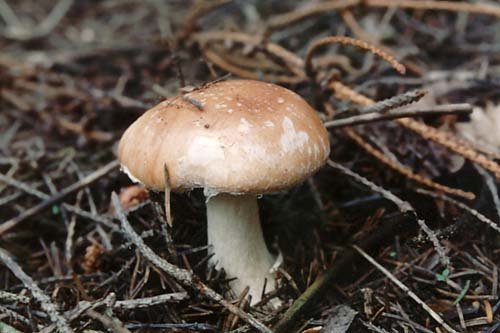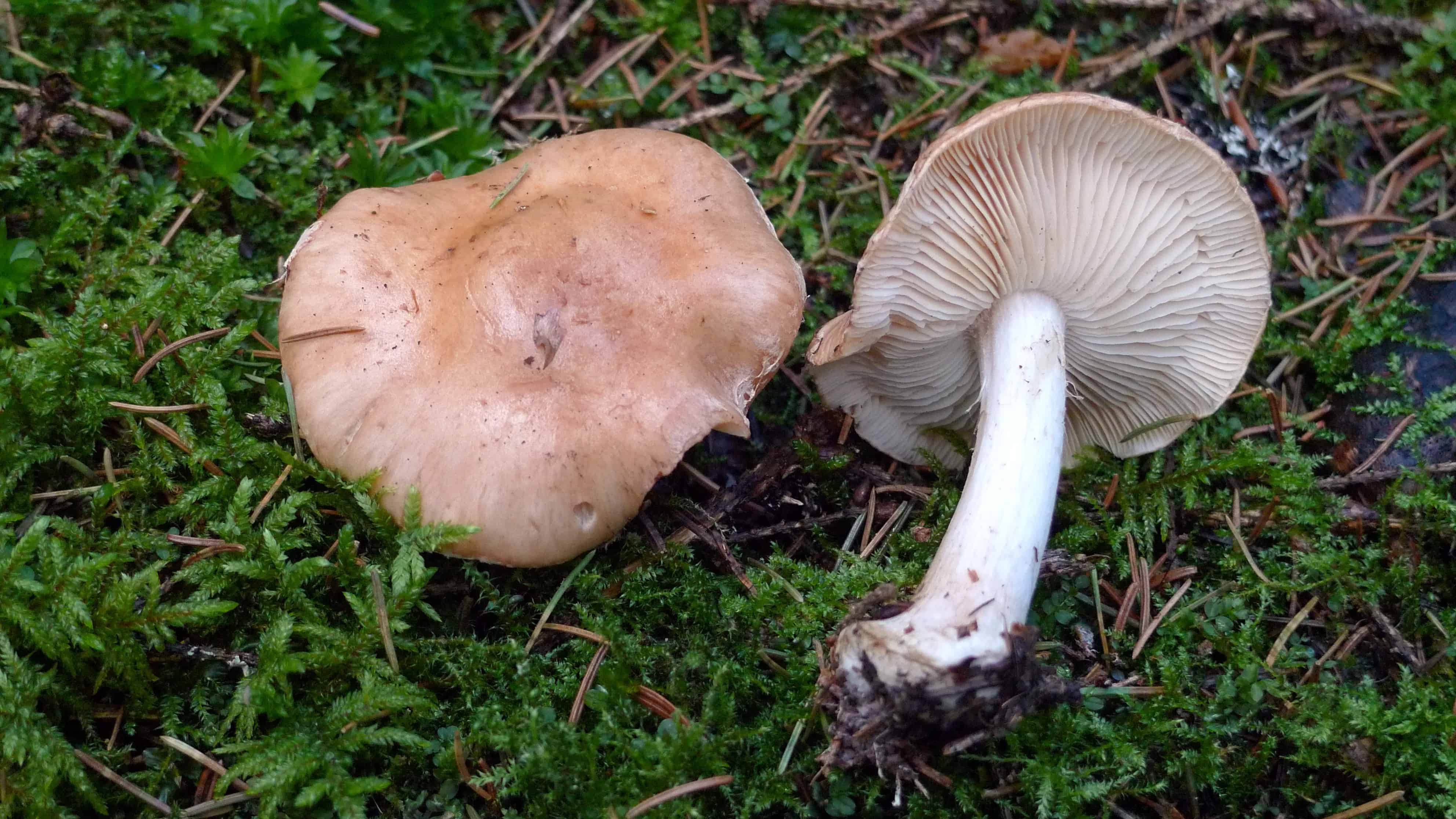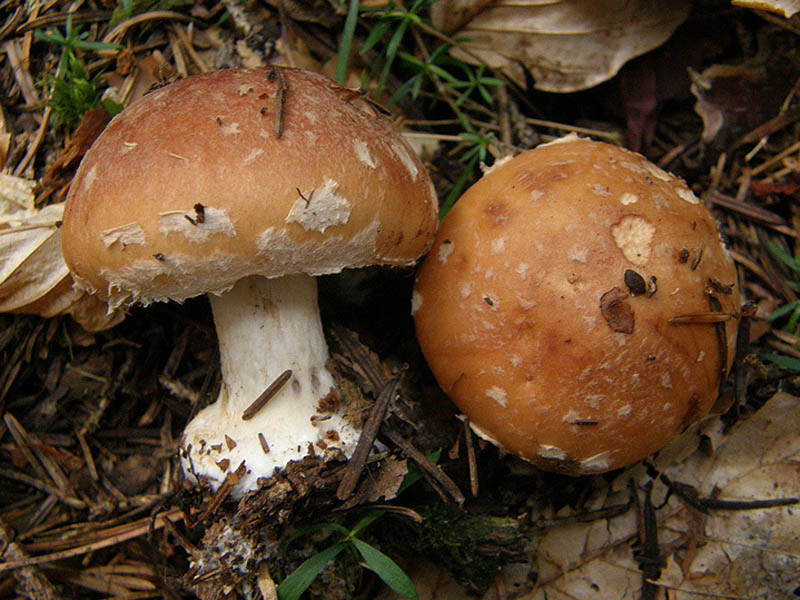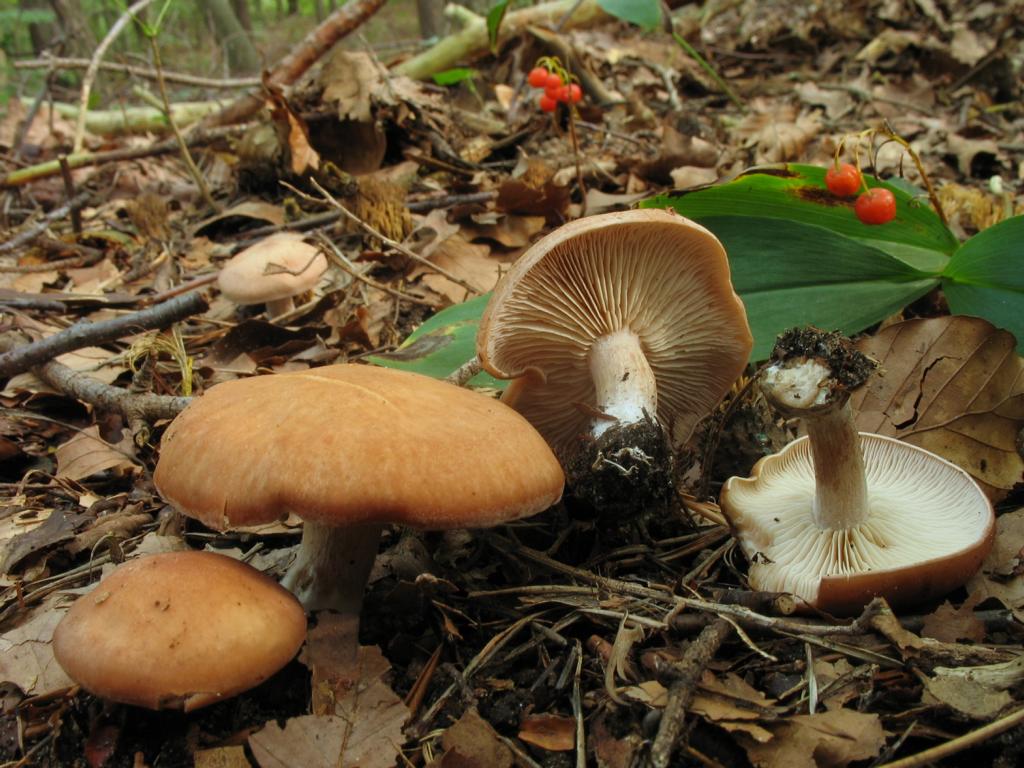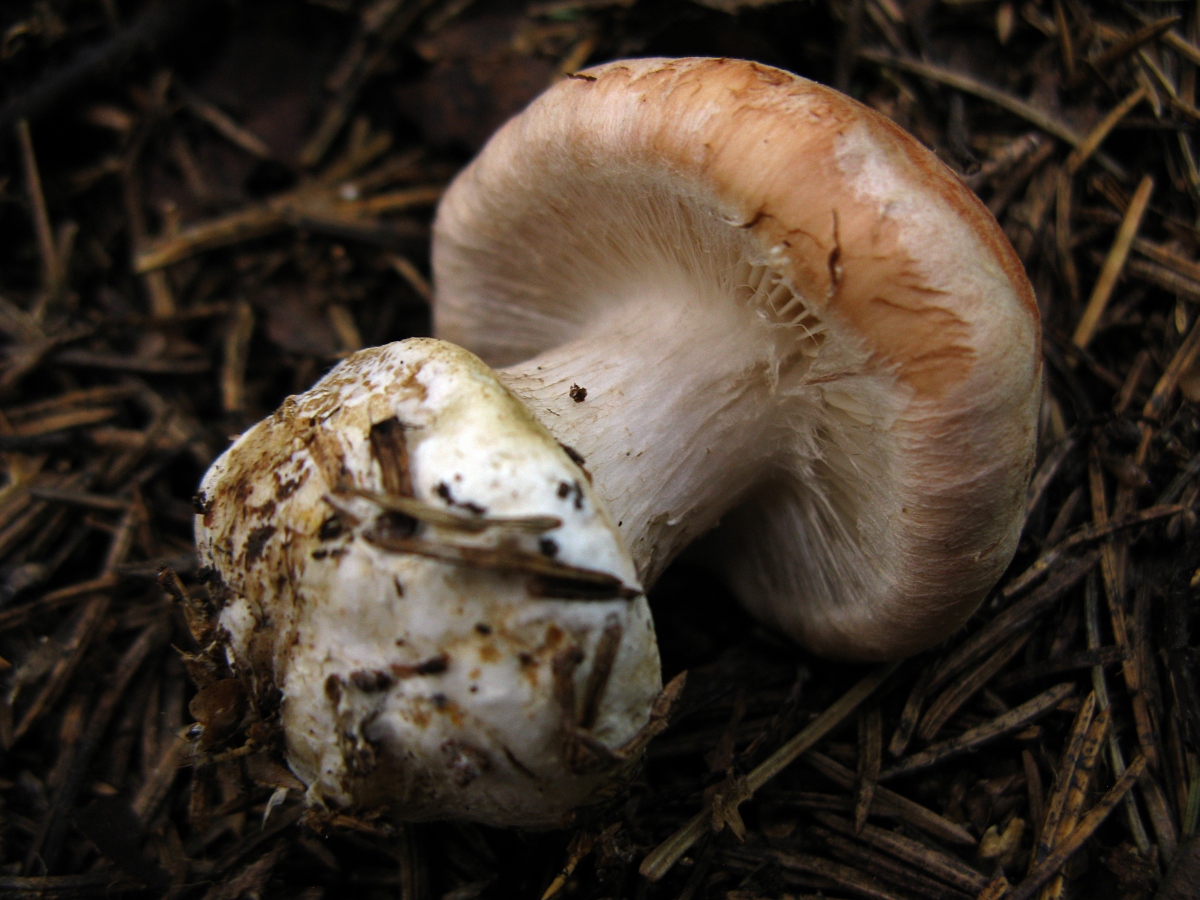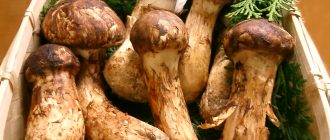Bulbous webcap
Tuberous white-webbed
Hat: Diameter 4-8 cm, in young specimens it is semi-ovate or bell-shaped, gradually opens to semi-extended with age; a blunt tubercle persists for a long time in the center. The edges of the cap are covered with white remnants of the cortina, which are especially noticeable in young specimens; color indefinite, rolling, from cream to dirty orange, the surface is smooth and dry. The flesh of the cap is thick, soft, whitish, without any particular smell or taste.
Plates: Adherent to the tooth, frequent, narrow, white in youth, then darken to cream (unlike other cobwebs, due to the white color of the spore powder, the plates do not acquire a completely dark color even in adulthood). In young specimens, the plates are covered with a white cobweb cortina.
Spore powder: White.
Stem: Short (5-7 cm in height) and thick (1-2 cm in diameter), white, with a prominent tuberous base; the ring is white, spider-like, free. Above the ring, the leg is smooth, below it is velvety. The pulp of the leg is grayish, fibrous.
Distribution: Occurs from August to October in coniferous and mixed forests, forming mycorrhiza with pine and spruce.
Similar species: From the spiderweb family, this mushroom certainly stands out with a white spore powder and plates that do not darken until old age. It should also be noted a slight resemblance to an extremely unfortunate specimen of the red fly agaric (Amanita muscaria): the white remnants of the cortina at the edges of the cap resemble half-washed warts, and the pinkish-cream color is also not uncommon for a very faded red fly agaric. So such a distant resemblance would rather serve as a good distinguishing feature of a white-webbed rather than a reason to eat a red fly agaric by mistake.
Edible: Considered a medium quality edible mushroom.
Remarks Bulbous whitebird is one of the few mushrooms recognizable at first sight. As I remember now: I was walking through an old spruce forest, heavily loaded with saffron milk caps and umbrellas, and suddenly noticed a flock of stocky reddish fungi. “Bah, that's the same…”, - no, of course, the word “white-webbed” or, forgive me, Lord, “Leucocortinarius bulbiger” would be unnatural to remember, but recognition came instantly. Lucky, very lucky mushroom. Just pick it up and eat it.
How, when and where to collect
Tuberous white-webbed occurs in pine, deciduous and mixed forests from August to late October. It can be found both in groups and singly on soil and litter. It often grows under oak, spruce, pine, beech. Distribution area: in the Crimea, Europe, Asia, the Far East and Ukraine. This rare species is listed in the Red Data Books of some regions of Russia.
It is best to pick mushrooms 3-4 days after rain. It is recommended to cut off only the fleshy caps, since the legs do not differ in a special taste and are too watery. In order to come back to the place where the white-webbirds grow next year, it is necessary to carefully cut off the cap with a knife, leaving part of the leg in the ground. This will keep the mycelium intact. It also needs to be sprinkled with moss or earth.
There are no twins, but there are mushrooms that outwardly resemble white-webbed ones:
- A red fly agaric that has burnt out and turned pale. The white-webbed differs from the poisonous twin in a thick leg and a cobweb ring with sharp ends. However, in dry weather, the leg may stretch a little and become thinner, and the ring becomes almost invisible. For an experienced mushroom picker, it will not be difficult to distinguish between these two mushrooms. Their distant similarity can confuse only beginner lovers of "quiet hunting".
- The cobweb is edible. It is customary to call him a fat woman. It is a mushroom that has a yellow-brown spore powder and a whitish-gray cap.
- Sparkling webcap. This is another of the representatives of the Webinnikov family. It is distinguished by the darker color of spore powder and plates.In the white-webbed, they do not darken even with age.
You can cut the mushroom only if there is no doubt about its edibility. You cannot try them in their raw form, and it is better not to pluck old specimens, because they accumulate a lot of toxins. It is better to take an experienced mushroom picker with you to the forest.
Even an edible mushroom can turn out to be poisonous, so it is not advised to buy white webs from private individuals. They can be harmful to health, because they could be collected along highways or in areas with poor ecology.
At home, after picking mushrooms, you must carefully consider each and make sure that there are no foreign species among them. Store the collected white web in a dry place.
Cooking use
Bulbous weevil is an edible or conditionally edible mushroom of average quality. Before use, it is advised to boil it for 15-20 minutes. The resulting broth is not suitable for food, it must be poured out. The mushroom is used in salted, canned, salted, fried and stewed forms.
Some experienced culinary specialists use certain types of webcases for cooking. It is believed that it is this product that gives the dish a certain nutty flavor. However, most chefs believe that the tuberous whiteweb has no flavor value. It's all about personal tastes and preferences.
Buckwheat with white-webbed in a cauldron
Porridge with these mushrooms turns out to be tasty and crumbly. You can use assorted mushrooms. This dish is suitable for both lunch and dinner. To prepare it, you need the following ingredients:
- 300 g of mushrooms;
- 300 g of buckwheat;
- 1 onion;
- 1 carrot;
- butter and vegetable oils;
- salt;
- pepper.
Step by step cooking:
- It is necessary to heat the cauldron over a fire and melt butter and vegetable oil in it. Next, pre-prepared mushrooms are added to the container and cooked over high heat until all the water has evaporated.
- Carrots are finely chopped and placed in a cauldron. Onion half rings are also added here.
- After 2-3 minutes, the washed cereal is poured, spices are added and boiled water is poured over it so that the cereal is covered by 1 cm. After the water has boiled, the cauldron is covered with a lid and everything is simmered over low heat for 30 minutes.
- The finished dish is salted, pepper and served with a vegetable salad.
Mushrooms with cheese and herbs
According to the following recipe, you can cook any edible type of mushrooms from the Spiderweb family. It requires:
- 500 g of fresh tuberous white-webbed;
- vegetable oil;
- 150 g fat sour cream;
- 1 tablespoon flour;
- 30 g of hard cheese;
- greens;
- salt pepper.
How to cook, three steps:
- It is necessary to boil a little water and boil the washed mushrooms in it for 15 minutes. Then they are taken out of the liquid, cooled and cut into pieces on the centerpiece.
- Next, the mushrooms are fried in oil so that they are covered with a golden crust. Flour is added 2 minutes before the end of frying. Then sour cream is poured into the pan and allowed to boil.
- Pour grated cheese on top and after 1-2 minutes add chopped herbs, salt and pepper.
This dish is perfect with potatoes, pasta and cereals.
Bulbous white-web (White-web tuberous): photo and description
| Name: | Bulbous webcap |
| Latin name: | Leucocortinarius bulbiger |
| Type of: | Conditionally edible |
| Synonyms: | |
| Systematics: |
|
Bulbous webcap is a rare mushroom found in only a few regions of Russia. The only representative of the genus Leucocortinarius is famous for its good taste.
What does the bulbous white-webcap look like?
Bulbous webbing (Leucocortinarius bulbiger) or tuberous is one of the most recognizable mushrooms of the Ryadovkovy family. Also called the white spider web. It is difficult to confuse it with representatives of another species, since the height of the fruiting body reaches 8-10 cm.Also, this specimen can be recognized by its characteristic distinguishing features.
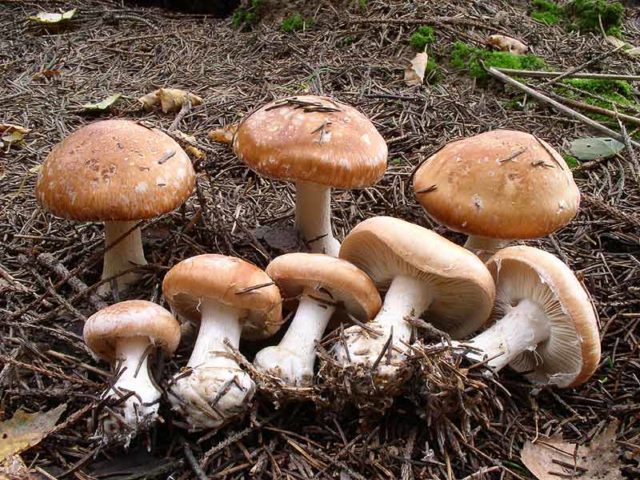
The representative of the genus Leucocortinarius is distinguished by its impressive size
Description of the hat
The cap is very large and can reach 10 cm in diameter. In young specimens, it has a spherical shape with concave edges. In mature, the top of the fruiting body becomes more convex, and its edges are wavy. The color is cream, brown-orange, dark red with light growths characteristic of this species.

On the cap there are white flakes characteristic of this type - the remnants of a private bedspread
Under the cap there are frequent narrow plates of the hymenophore of a cream or light brown color. With age, they darken and acquire a reddish-brown tint.
Leg description
The stem of the fruiting body is solid, cylindrical. The color is whitish, with age it can darken to dark cream or brown. The length of the leg reaches 8-10 cm, and its thickness is 2 cm.
The pulp of the fruiting body is juicy, tasteless and odorless, white or light gray in color (leg).

A characteristic feature is the presence at the base of the leg of a thickening and a white cobweb ring
Where and how it grows
This is a rather rare representative - you can rarely meet him. It grows in groups in coniferous (spruce, pine) and mixed forests on the territory of Western and Eastern Siberia, the Far East, and some regions of the European part of Russia. The collection period is from August to October.
Is the mushroom edible or not
Considered conditionally edible. You cannot use this product in its raw form - only after boiling for half an hour, followed by frying, stewing or preserving the product. You should not purchase the bulbous webcap from private hands, since even an edible specimen, for example, collected near a highway, can be poisonous. Also, do not eat old copies.
Doubles and their differences
The tuberous webcap is the only one of the genus Leucocortinarius. However, there are several specimens that are similar in appearance to it.
Light ocher webcap (Cortinarius claricolor) - inedible and poisonous twin, does not have a characteristic tuberous thickening, the color of the cap is warmer with a reddish tinge.

More common on sandy soils
Amanita muscaria is inedible and hallucinogenic. You can distinguish a double by a thin leg, creamy plates, a cobweb ring with sharp edges. During the drought period, these signs are not so pronounced, therefore, it is worth picking fruits only in rainy weather and together with an experienced mushroom picker.

Amanita muscaria with a faded cap looks very similar to the white-web bulbous
Conclusion
Bulbous white-webbed is a little-known mushroom that is extremely rare in the coniferous forests of Russia. The representative of the Ryadovkovy family is not famous for its high taste. However, experienced mushroom pickers appreciate this representative, first of all, for its impressive size.
It is important not to confuse the white spider web with outwardly similar twins, so every mushroom picker should be able to distinguish and recognize this specimen.
Useful properties and possible harm
Benefit:
In medicine, mainly poisonous species of the Webinnikov family are used. White-webbed is used mainly for culinary purposes. However, it contains useful amino acids, macro and microelements, vitamins and therefore is perfect for dietary nutrition. It is advised to combine it with foods that contain complex carbohydrates. These foods will help reduce your appetite. This type of mushroom also has other useful properties:
- removes harmful cholesterol;
- strengthens the walls of blood vessels;
- has an antioxidant effect;
- strengthens the immune system;
- improves the appearance of hair and nails;
- fills the body with energy.
People who often eat mushrooms are less susceptible to cardiac pathologies and the development of cancerous tumors. It is allowed to include white webs in your diet 1-2 times a week.
Harm:
These mushrooms will not be of much benefit to those who suffer from diseases of the digestive organs, because the white web is considered heavy food and is difficult to digest in the stomach. For this reason, they cannot be included in the diet of children and pregnant women.
Excessive consumption of mushrooms can lead to the development of pancreatitis and other problems in the digestive tract. In some cases, you should consult your doctor before using the product.
Description of the mushroom
Its cap reaches a diameter of 10 cm. It can be brownish-orange, dark cream, dark red. In dry weather, it begins to fade. In young specimens, it is spherical with light, curved edges. In more mature mushrooms, it is convex, has a wide tubercle, and its edges are wavy. There are light-colored flakes on the surface of the cap.
The leg of the mushroom is white, it reaches 8 cm in height and up to 2 cm in diameter. It has a sharply defined large nodule at the base. This is a characteristic feature of this species. There is a white ring on the leg. Above it, the surface is smooth, and below it becomes velvety.
White-webbed belongs to lamellar mushrooms. Its plates are not wide and frequent. They are usually light, creamy or clayey, and brownish with age. The flesh of the mushroom is soft and light; in the stem it is watery and grayish. Has no particular taste. Spore white powder.
White-web tuberous - Leucocortinarius bulbiger
Written by Nikolay Budnik and Elena Meck.
We rarely met the bulbous webcap on Ulom Zheleznaya. Actually, its correct name is Bulbous or tuberous white-webbed. It is named so because of the tuberous thickening at the base of the leg.
It is a small mushroom that grows in August - September. It's considered edible, but we haven't tried it. Therefore, we cannot say anything about the taste of Whitewebweb.

1. Tuberous white-webbed is quite a pretty mushroom.

2. It is somewhat similar to a fly agaric.

3. White warts are visible on the light ocher cap of the mushroom.

4. Sometimes they are very noticeable.

5. . and sometimes the cap of the mushroom is almost naked.

6. But still, the mushroom is beautiful and gentle.

7. We met white-webbed in mixed pine-birch forests with a predominance of pine.

8. It grows in groups, rarely found alone.

9. These white web crawlers grew up on our site.

10. In this photo you can see rowan and willow undergrowth among the pines.

11. And then the white-webbed grew up in the open space.

12. Here we see them among last year's foliage.

13. White-webbed is a small-sized mushroom.

14. This is how middle-aged mushrooms look like.

15. In old mushrooms, the cap is also small.

16. And this is the average height of the leg.

17. The cap of the white-webbed is sometimes covered with sparse white hairs.

eighteen. . and sometimes practically naked.

19. In young mushrooms, the edges of the cap are bent inward.

20. Gradually the hat opens.

21. It is ocher in color with a darker center.

23. In old age, the cap becomes looser and more uneven.

23. Here, along the edge of the opened hat, lines are visible - the remains of the bedspread.

24. This is how the cap joins the leg.

25. Plates of young mushrooms are light, almost white.

26. At first, they are covered with a cobweb blanket.

27. Gradually the cobwebs disappear.

28. In older mushrooms, the plates are completely open.

29. Gradually the plates acquire a clay tint.

30. In old mushrooms, they are very dark, clay-brown.

31. This is how the plates are connected to the leg.

32. Let's look at this connection again.

33. Stem almost white, strongly thickened at the base.

34. This is especially noticeable in young mushrooms.

35. Because of this thickening, the cobweb was called tuberous.

36. Then the leg becomes thinner.

37.. and the bulb at its base decreases.

38. This is how the legs are attached to the ground.

39. The leg is almost solid, incomplete.

40. Only in some mushrooms the leg has a small cavity.

41. This is a cut of the leg of an old mushroom.

42.. and this is young.

43. The flesh of the white-webbed is almost white.

44. She is juicy and tender.

45. Young mushrooms have strong and juicy flesh.

46. Only in old age do mushrooms become less fleshy.

47. White web crawlers are rarely wormy.

48. I'll have to try these cute mushrooms.

49. In the meantime, let's just admire them.
The film of 2017 about the Tuberous White-webbed



